Hey everybody! Nearly two months ago I wrote an article about evaluating different creatures in Magic: The Gathering (which you can find here). Today, I plan to do the same thing, but with spell abilities instead. If you are interested in designing your own trading card game, or simply want to learn more about Magic: The Gathering, then this is the article for you!
Alright, We’ll Call it a Draw
One of the most basic abilities to be put onto a Magic card is simply the ability to draw a card. However, not all card drawing is made equal. In Magic, there is a concept known as “card advantage”, which can play a huge role in the outcome of any particular game.
While card advantage is a huge topic in and of itself, the most simple explanation is “the more cards a player has access to, the more likely they are to win”. Cards that draw more cards, naturally, are a huge part of creating card advantage. However, the number of cards being drawn plays a huge role in the cost of the card. Therefore, I will be looking at drawing different numbers of cards separately.
- Draw a Card
Drawing a single card is an extremely common ability to put on a Magic card. In fact, this ability is so common that there is a special name for cards that, in addition to their main ability, also draw you a card when they are played. These cards are referred to as “cantrips”, and often add the card drawing ability to make up for a relatively weak or situational main ability. There is also another mechanic known as Cycling, which gives you a choice between the card’s ability or drawing a card.
Drawing a single card is also unique among card drawing in the sense that it doesn’t, on it’s own, create any card advantage. When you play a card to draw a card you are not actually gaining anything – you still have access to the same number of cards as before, just one of them is different. You don’t go down in card advantage, but you don’t go up either.
 All of that being said, how much does this ability cost? Well, that depends. As cards like Urza’s and Mishra’s Bauble show, this ability on it’s own is not even worth a single mana. However, when paired up with other abilities it can be a different story.
All of that being said, how much does this ability cost? Well, that depends. As cards like Urza’s and Mishra’s Bauble show, this ability on it’s own is not even worth a single mana. However, when paired up with other abilities it can be a different story.
When you give a card the ability to draw a card in addition to it’s normal ability, this tends to increase the value of the card by about 2. It is extremely common to design cantrips this way – simply take a known ability, add a card draw to it, and increase the cost by two.
In addition to simply adding card draw to a known ability, cantrips can also allow certain abilities to be created that would otherwise not be worth a single mana. An example of this is Agressive Urge, which was recently reprinted in Rivals of Ixalan. This card costs 1 and a green, and has the ability “Target Creature gets +1/+1 until end of turn. Draw a 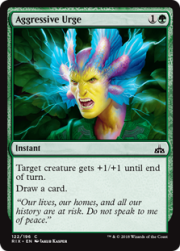 card”.
card”.
This card would be so weak without the card draw that it would never get made, but if it had a more powerful ability it probably would have to cost more mana. A higher cost would significantly weaken the card, as combat tricks require players 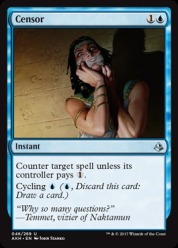 to not spend some of their mana during their own turns.
to not spend some of their mana during their own turns.
For cycling cards, which require players to choose between the ability or the card draw, the average cost is usually either 2 colorless mana or, occasionally, a single colored mana. These cards tend to be slightly weaker or slightly more expensive than their non-cycling counterparts, but make up for it by being extremely flexible.
- Draw Two Cards
The big difference between drawing a single card and drawing two cards is that now you are actually going up in card advantage. You are gaining more cards than you started  with, which means that you are going to be paying quite a bit more. While drawing a single card (on it’s own) can cost 0-1 mana, drawing two tends to cost about three.
with, which means that you are going to be paying quite a bit more. While drawing a single card (on it’s own) can cost 0-1 mana, drawing two tends to cost about three.
Unlike “Draw a card”, drawing two cards tends to stand more on its own. While drawing a single card tends to be a bonus that gets added on to other effects, drawing two cards is a big enough ability that it doesn’t tend to get mixed in the same way. However, that isn’t to say that it never gets combined with other effects, just that when it does it tends to be a bigger part of the picture.
This ability is often mixed with life gain (as a small bonus) or life loss (as an additional cost). It can also be mixed with synergistic effects like Scry (which I will talk about soon) and is also often paired with discard effects due to opposing nature of the two abilities.
- Draw 3+ Cards
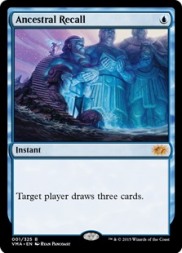 How much does it cost to draw three cards? Definitely not a single blue mana, that’s for sure. In modern sets, every card after the second one tends to cost about an additional mana for each (4 mana for 3, 5 mana for 4, etc). At this point, these cards tend to be dedicated card advantage, and are almost never mixed with other abilities.
How much does it cost to draw three cards? Definitely not a single blue mana, that’s for sure. In modern sets, every card after the second one tends to cost about an additional mana for each (4 mana for 3, 5 mana for 4, etc). At this point, these cards tend to be dedicated card advantage, and are almost never mixed with other abilities.
- Repeated Card Draw
All of the abilities listed so far have been single use effects. However, there is also another category of card drawing abilities that allow players to draw multiple times by either paying mana or achieving some condition.
If the ability is simply to pay some mana and draw a card, these abilities tend to cost about 3-4 mana. However, most of these abilities tend to have some additional requirements for the card draw, which can reduce the cost. These extra requirements can range from causing damage to the opponent, to having the largest creature, to having the fewest cards in hand.
Cards that simply require mana to draw tend to be more expensive because they can be used multiple times each turn. On the other hand, if an ability requires a tap to activate, then it tends to be much cheaper because it can only be used once per turn. Because of the initial mana and card investment, it can take several turns for these sorts of cards to become valuable, but if they can stay out for many turns they can gain huge amounts of card advantage.
A subset of this category is commonly found in black, where life is traded for card advantage. There are several cards in this category, such as Yawgmoth’s Bargain, Necropotence, and Dark Confidant, which are considered some of the most powerful 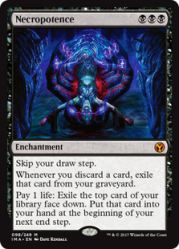 cards ever printed. While black still can pay life to draw cards, these effects now tend to be one-shots instead of repeatable abilities.
cards ever printed. While black still can pay life to draw cards, these effects now tend to be one-shots instead of repeatable abilities.
Needing a Filter
Aside from pure card drawing, there is also what is known as card filtering. These abilities involve getting rid of cards in your hand (either by sending them to the graveyard, exiling them, or shuffling them back into the deck), and drawing new cards to replace them.
Card filtering comes in many varieties. Some card filtering, particularly in red, requires discarding the card first, then drawing. This has the advantage that if you don’t have 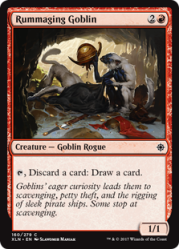 very many cards in your hand you can actually gain card advantage through these abilities. That being said, these abilities are, on average, slightly worse than their blue counterparts which allow you to draw first, then discard. This gives you more options when discarding, and allows you to keep the cards that you want.
very many cards in your hand you can actually gain card advantage through these abilities. That being said, these abilities are, on average, slightly worse than their blue counterparts which allow you to draw first, then discard. This gives you more options when discarding, and allows you to keep the cards that you want.
In addition, there is also a difference in the number of cards that get filtered. For example, if a card draws and discards the same number of cards, this is actually card disadvantage – you break even on the effect, but you are still using up a card to do it. Therefore, these types of abilities tend to be heavily discounted.
If a card discards 1 less than it draws, then you break even. While this could be considered comparable to drawing a single card, in most cases it is considerably better. This is because you have a choice of which card to keep and which to get rid of, which gives you a much better chance of getting one of the cards you want.
When costing these cards, it’s important to keep in mind how many cards you actually get to see. The more cards you have to choose from, the more you would be willing to  pay. The total cost tends to be somewhere in the middle of the number of cards you get to see, and the number of cards you get to keep.
pay. The total cost tends to be somewhere in the middle of the number of cards you get to see, and the number of cards you get to keep.
For example, take a card such as Compulsive Research that allows you to draw 3 and discard two. Clearly this card should cost less than a card that simply allows you to draw 3 cards (which would cost about 4 mana). On the other hand, it allows you to keep one of your cards, so it should cost more than a card that simply lets you draw a single card (about 1 mana). Therefore, this card should cost somewhere in the range of 2 or 3 mana. Compulsive Research costs 3, because the ability to sometimes keep two cards makes it more expensive. However, I could see a version of this card that only costs 2 without that possibility (maybe with two blue mana).
Impulse Purchase
One relatively new effect that has been added to Red’s slice of the color pie is known as Impulsive Draw. Impulsive Draw allows red cards to exile cards from the top of the deck  until the end of the turn, and they can be played while they are exiled. This basically amounts to a form of temporary card drawing – you get the cards, but only until the end of the turn. Impulsive draw tends to cost slightly less than an equivalent draw spell, although it does have severely diminishing returns as you can only cast so many spells in a single turn.
until the end of the turn, and they can be played while they are exiled. This basically amounts to a form of temporary card drawing – you get the cards, but only until the end of the turn. Impulsive draw tends to cost slightly less than an equivalent draw spell, although it does have severely diminishing returns as you can only cast so many spells in a single turn.
Scry Me a River
Finally, the last ability we are going to look at today is Scry. The Scry ability allows you to look at a certain number of cards from the top of your deck, and put them on either the top or bottom of your deck. Its sort of a delayed form of card filtering – it doesn’t actually increase your card advantage, but it does allow you easier access to the cards that you want.
On it’s own, Scrying costs almost nothing. In fact, the card Reason // Believe allows players to Scry 3 for a single blue mana. However, Scry is rarely used on it’s own on 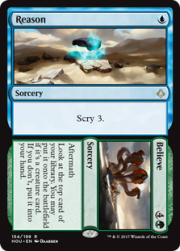 cards. Much like “Draw a card”, Scry can be added to other card effects as a small bonus. Unlike cantrips, however, adding Scry doesn’t tend to increase the cost of the card it is placed on. The exception is when Scry is combined with synergistic abilities, such as card draw or abilities that care about what is on the top of your library.
cards. Much like “Draw a card”, Scry can be added to other card effects as a small bonus. Unlike cantrips, however, adding Scry doesn’t tend to increase the cost of the card it is placed on. The exception is when Scry is combined with synergistic abilities, such as card draw or abilities that care about what is on the top of your library.
Drawn in Color
While the above costs are general guidelines, it’s important to note that different colors deal with card draw differently. While every color gets some common effects, such as cantrips, Cycling and Scry, most other card drawing abilities are dependent on color.
For example, blue tends to get the best card draw in general, while red’s card draw is more impulsive and tends not to gain much card advantage. Green has powerful card drawing abilities, but they tend to be more connected to it’s creatures, while Black tends to require additional costs, such as life or sacrifice for it’s card advantage.White’s card drawing tends to be relatively weak, and very narrow.
 Because of these differences, a draw spell that would be relatively mediocre in blue might actually be amazing in white! However, this isn’t to say that white doesn’t have any good spells of it’s own. For example, if you are playing a vehicle heavy deck a card like Sram, Senior Edificer has the potential to draw an absurd number of cards. As always, however, it is important to keep the overall structure and goal of your deck in mind, and choose the draw spells that will best support that strategy.
Because of these differences, a draw spell that would be relatively mediocre in blue might actually be amazing in white! However, this isn’t to say that white doesn’t have any good spells of it’s own. For example, if you are playing a vehicle heavy deck a card like Sram, Senior Edificer has the potential to draw an absurd number of cards. As always, however, it is important to keep the overall structure and goal of your deck in mind, and choose the draw spells that will best support that strategy.
Until Next Week!
That’s all I have for this week! As always, I would love to hear your feedback in the comments below or on social media. If you would like to see more articles like this in the future, let me know in the comments or on social media. And if you have any suggestions for future entries in the series, or future articles in general, I would love to hear them. If you are interested in seeing more of my articles in the future, be sure to subscribe to the blog on Facebook, Twitter, or here on WordPress so you will always know when I post something new. And join me next week, where I will be looking at player psychographics to figure out the different reasons that people play games!

